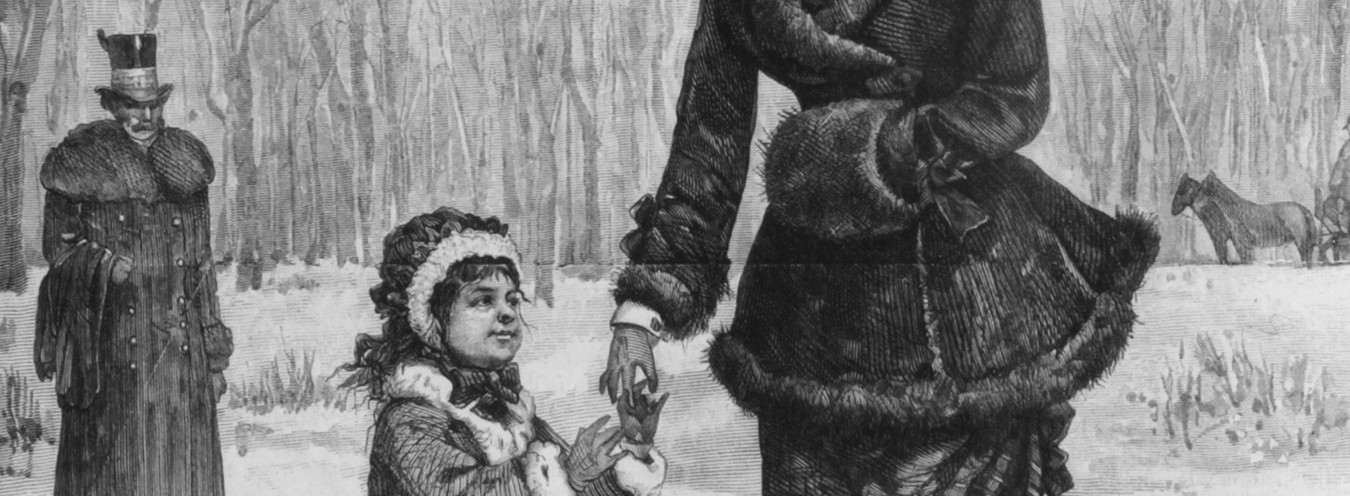
The Trial for the Theft of a Doll
The judge went on writing for a while, and when he had finished he informed those present that Krzeszowska’s case against Mrs Stawska over the theft of a doll would be heard. (552)
The criminal trial initiated through private prosecution, without the participation of the prosecutor, by Baroness Krzeszowska against Helena Stawska for the theft of a doll (allegedly bought at Lesser’s) is judged by a magistrate: a court of first instance which, in the time of Congress Poland, could examine cases related to criminal offences. At the Baroness’ request, the main trial is preceded by a search of Stawska’s flat, conducted by Krzeszowska in the presence of a constable. The Baroness accuses Stawska of stealing the doll and insists on her arrest. She also demands that the doll be taken away and that minutes be taken from the proceedings. Stawska is summoned to the police station to make a statement.
The trial takes place in the magistrate’s office, equipped with two rows of benches for the parties, as well as sitting and standing places for the public. Representatives of the prosecution, Baroness Krzeszowska and her counsel, sit on the one side of the table, and on the other – the defendant Helena Stawska, her lawyer, and the witnesses for the defence. The magistrate (single judge) examines the case; the questioning of the parties and witnesses brings no arguments sufficient for a sentence to be passed. It is only after an examination of the doll, presented by the defendant, that Helena Stawska can be acquitted. The toy’s body undergoes an operation performed with a knife – a sort of execution – as its head was cut off and a stamp of the company “Jan Mincel and Stanisław Wokulski” is exposed. The inquiry by the magistrate and further questioning irrefutably indicates that the accusation has been completely groundless.
In the course of the trial, the magistrate rejects the false claims and allows the innocent woman to regain her good name and the public’s respect. Prus depicts the magistrate’s behaviour as laudable; after ending the trial and pronouncing the sentence, he pays his respects to Stawska.
The “doll trial,” an important strand of the plot and, according to Prus himself, the source of the novel’s title, is based on a real-life story, which took place in 1887 in the Moravian city of Brno, where, thanks to a “post-mortem” of a toy a slandered young widow’s innocence was proved.
A fragment of the main hearing of a criminal lawsuit related to a serious crime is also shown in The Doll. Prus depicts this scene, too, in a comical convention. Here, Rzecki accidentally finds himself in a courtroom while the prosecutor reads out the indictment and the accusations therein: It was stuffy in the court-room; the prosecutor’s speech was somewhat drowned by the rattle of droshkies outside. The magistrates looked as if they were dozing, the lawyer yawned, the accused looked as if he would be delighted to defraud the judges of the supreme court, the Hebrews were eyeing him with sympathy and listened to the charges with attention.
An analysis of the course of criminal lawsuits in the era of The Doll – also those shown in the novel with a considerable dose of humour – demonstrates an important transformation taking place at the time: the functions of prosecution, defence, and judging were separated. The defendant is a party in the trial and gains the legal guarantee of defence. The judge is duty-bound to listen to both parties and consider the arguments and evidence presented. The openness principle is preserved throughout the trial. The judge is in direct contact with the witnesses and, having examined the evidence, pronounces the sentence on the basis of his own observations, reasoning, and conscience. The judge may evaluate the evidence freely, and he can also legally deem anything to be evidence if it permits them to establish the truth and sheds light on the circumstances attesting to the guilt or innocence of the defendant. The depiction of the trial evidences that Bolesław Prus knew his way around contemporary legal intricacies.
→ The Doll;
Bibliografia
- H. Markiewicz, Inna zabawa Lalką, in S. Godlewski et al, Śladami Wokulskiego. Przewodnik literacki po warszawskich realiach Lalki, Warsaw 1957.
- S. Milewski, W świetle występku i zbrodni. Z dziejów przestępczości i jej zwalczania, Warsaw 1996.
- K. Sójka-Zielińska, Historia prawa, Warsaw 2009.
- S. Waltoś, Proces karny. Zarys systemu, Warsaw 2009.



